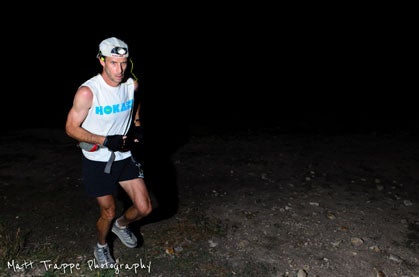Karl Takes Home the Cash

100-mile master Karl Meltzer uses his ultrarunning wisdom to outlast a stacked men’s field; Lizzy Hawker dominates the women’s race at Run Rabbit Run
Photo by Matt Trappe
Karl Meltzer says it frankly: he never expected to come out on top at the inaugural Run Rabbit Run 100 in Steamboat Springs, Colorado, last weekend.
“I did not think I would be in contention to win. I was only hoping to run top five and win the masters’ division,” says Meltzer, of Sandy, Utah. “But when I was only a few minutes back through 40 [miles], I knew I was in the race to win, so I stayed on my game plan and it went perfect. This race has long downhills and my strategy was to take those easy.”
He would be pleasantly surprised. Late in the race, Meltzer flew past several early leaders from the stacked men’s field, including 2012 Western States champion, Timothy Olson, and 2011 The North Face Endurance Challenge 50-Mile Championship San Francisco winner, Mike Wolfe, to win in 19:16:02.
““[At mile 69], my legs felt fresh and ready to race,” he says. “One-hundred-mile races start at mile 70. I had no bad patches, which is usually what it takes to win a race like this.”
That was not the case for Lizzy Hawker, who injured her knee in a hard fall early in the race but nonetheless led the contest from start to finish.
“Unfortunately, from [the fall] onwards, I really had to then just focus on dealing with the pain, rather than being able to enjoy racing,” says Hawker, who currently resides in Scuol, Switzerland. “At no point in the race did I think I had a lock on the win. I knew I had some lead, but in a 100-mile race it is so easy to lose time on just one climb or descent.”
The women’s elite field would only see four runners finish (prize money was reserved for the top five in the elite, or “Hares,” race). Several elite men and women dropped for a variety of factors, including injury and difficulty following course markings.
“Yes, [the course markings] could have been more frequent and perhaps a little more obvious at strategic points,” Hawker says. “But we had been warned both on the race website and at the pre-race meeting that it was our responsibility to know where we were going.”
“The course markings were hard to follow because they were yellow and the leaves were going off (again, yellow). Fortunately, I never missed a turn, but a lot of racers did. I’m sure that contributed to the high attrition rate,” says Ashley Arnold, of Carbondale, Colorado, who made an early decision to drop from the race. “When I was running down the pavement into the 21-mile aid station, though, I did second-guess myself and stop to look around a few times because I hadn’t seen flags in ages.”
One unique feature of Run Rabbit Run was that the Hares race started late in the afternoon Friday and took elite runners through the night and drastic temperature changes.
Meltzer speculated that the adverse conditions may have been conducive to a veteran of dozens of 100-mile races like himself.
“I left it all out there, but not early, the way a smart old man runs 100 miles,” he says. “It was a perfectly executed race.”
Complete results from the elite race can be found here.